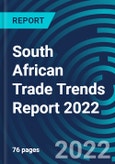Introduction
As South Africa is a small, open economy, international trade can be seen as the engine room of its economy. With total trade worth R3.2tn in 2021, and a contribution of almost 60% to GDP, an increase in trade can steer the country onto a new and elevated growth path. The huge positive trade surplus in 2021 came on the back of the commodity boom which benefited minerals exports, while higher prices for the import of oil, wheat, sunflower oil and fertiliser resulted in imported inflation. The potential that trade holds for the country can only be fully unlocked if South African companies are globally competitive, which is difficult in the current environment of failing road, rail and port infrastructure, electricity shortages and labour stoppages.Outlook
South African importers and exporters have the ability to change the growth path of South Africa fundamentally, even in a world where protective measures and localisation efforts are on the increase. Government must play its role in creating a stable economic environment free from impediments to international trade. Without world class infrastructure such as roads, rail and ports, products can’t reach their destinations. Electricity supply and costs must be resolved. The country must lessen its dependency on commodity exports. Commodity prices will come down in future and affect the trade balance. The concentration of trade partners imports presents a risk and efforts should be made to diversify. If companies make full use of market access opportunities and industrial support measures available, enhance their global competitiveness and re-align their growth strategies to be more outward-orientated, then the trade prospects are endless.Africa probably holds the most potential, with AfCFTA providing the impetus for eliminating trade barriers.
Report Coverage
This report on South African trade trends is one of Who Owns Whom’s series of trends reports. It includes information on trends by region, country and by product, various trade agreements and arrangements and the impact of external shocks and recent events.Table of Contents
1. INTRODUCTION10. IMPACT OF EXTERNAL SHOCKS11. OUTLOOK
2. TRADE AS CATALYST OF SOUTH AFRICA’S ECONOMIC GROWTH
3. SOUTH AFRICA’S TOTAL TRADE TRENDS
4. SOUTH AFRICA’S REGIONAL TRADE TRENDS
5. SOUTH AFRICA’S TRADE TRENDS BY PARTNER COUNTRY
6. SOUTH AFRICA’S TRADE TRENDS BY PRODUCT
7. SOUTH AFRICA’S TRADE WITH CHINA
8. SOUTH AFRICA’S TRADE WITH AFRICA
9. SOUTH AFRICA’S MAIN TRADE AGREEMENTS/ARRANGEMENTS
12. REFERENCES
Appendix
Methodology

LOADING...






